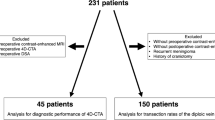Abstract
Purpose
To evaluate the capability of venography based on MR phase-sensitive imaging (PSI) in the visualization of internal cerebral veins (ICV) and their tributaries, and to concurrently describe their anatomical variants.
Patients and methods
A total of 100 consecutive patients underwent PSI MR examination. A minimum intensity projection image from PSI was generated and evaluated by two radiologists. Veins included in this study were ICV, thalamostriate veins (TSV), septal veins (SV), anterior caudate nucleus veins, medial atrial veins and lateral direct veins.
Results
With PSI-based venography, we clearly delineated ICV, SV, TSV, anterior caudate nucleus veins, medial atrial veins and lateral direct veins in 100, 98.5, 100, 92.5, 92 and 32% of 200 sides, respectively, within a group of 100 patients. In 80.5% of the sides, the TSV–SV–ICV junction was located adjacent to the posterior margin of the foramen of Monro; in 19.5% the junction was located beyond the foramen of Monro; and in 70.8%, the anterior caudate nucleus veins drained into TSV. In 21.6% of the sides, the SV, TSV and anterior caudate nucleus veins joined together to form the ICV. In 7.6% of the sides, the anterior caudate nucleus veins and TSV separately conjoined with SV or ICV. The pattern that the anterior caudate nucleus veins drain into SV or ICV is more frequent in the sides with TSV–SV–ICV in the posterior location. Of the 64 lateral direct veins, 59.4% of the sides were accompanied by an insufficient development of the TSV and 40.6% sides were normal. Enlarged direct lateral veins frequently accompany an insufficient development of TSV.
Conclusions
Phase-sensitive imaging-based venography showed its extraordinary detectability in demonstrating the anatomy and variants of ICV and their tributaries. The advantages of this technique are a relatively short examination time, and a non-invasive and contrast-free procedure. We propose that PSI-based venography may be a promising method to study the anatomy of subependymal veins, especially the tiny and tortuous ones.





Similar content being viewed by others
Explore related subjects
Discover the latest articles and news from researchers in related subjects, suggested using machine learning.References
Agid R, Shelef I, Scott JN et al (2008) Imaging of the intracranial venous system. Neurologist 14:12–22
Ayanzen RH, Bird CR, Keller PJ et al (2000) Cerebral MR venography: normal anatomy and potential diagnostic pitfalls. AJNR Am J Neuroradiol 21:74–78
Cimşit NC, Türe U, Ekinci G et al (2003) Venous variations in the region of the third ventricle: the role of MR venography. Neuroradiology 45:900–904
Fujii S, Kanasaki Y, Matsusue E et al (2010) Demonstration of cerebral venous variations in the region of the third ventricle on phase-sensitive imaging. AJNR Am J Neuroradiol 31:55–59
Giordano M, Wrede KH, Stieglitz LH et al (2007) Identification of venous variants in the pineal region with 3D preoperative computed tomography and magnetic resonance imaging navigation. A statistical study of venous anatomy in living patients. J Neurosurg 106:1006–1011
Giordano M, Wrede KH, Stieglitz LH et al (2009) Depiction of small veins draining into the vein of Galen using preoperative 3-dimensional navigation in living patients. Neurosurgery 64:247–251 (discussion 251–242)
Haroun A (2005) Utility of contrast-enhanced 3D turbo-flash MR angiography in evaluating the intracranial venous system. Neuroradiology 47:322–327
Huang YP (1976) Deep cerebral veins. In: Salamon G, Huang YP (eds) Radiologic anatomy of the brain. Springer, Berlin, pp 210–218
Huang YP, Wolf BS (1974) The basal cerebral vein and its tributaries. In: Newton TH, Potts DG (eds) Radiology of the skull and brain. CV Mosby, St Louis, pp 2111–2154
Kiliç T, Ozduman K, Cavdar S et al (2005) The galenic venous system: surgical anatomy and its angiographic and magnetic resonance venographic correlations. Eur J Radiol 56:212–219
Kirchhof K, Welzel T, Jansen O et al (2002) More reliable noninvasive visualization of the cerebral veins and dural sinuses: comparison of three MR angiographic techniques. Radiology 224:804–810
Lee JM, Jung S, Moon KS et al (2005) Preoperative evaluation of venous systems with 3-dimensional contrast-enhanced magnetic resonance venography in brain tumors: comparison with time-of-flight magnetic resonance venography and digital subtraction angiography. Surg Neurol 64:128–133
Liang L, Korogi Y, Sugahara T et al (2001) Evaluation of the intracranial dural sinuses with a 3D contrast-enhanced MP-RAGE sequence: prospective comparison with 2D-TOF MR venography and digital subtraction angiography. AJNR Am J Neuroradiol 22:481–492
Liauw L, van Buchem MA, Spilt A et al (2000) MR angiography of the intracranial venous system. Radiology 214:678–682
Loubeyre P, De Jaegere T, Tran-Minh VA (1999) Three-dimensional phase contrast MR cerebral venography with zero filling interpolation in the slice encoding direction. Magn Reson Imaging 17:1227–1233
Lövblad KO, Schneider J, Bassetti C et al (2002) Fast contrast-enhanced MR whole-brain venography. Neuroradiology 44:681–688
Pinker K, Noebauer-Huhmann IM, Stavrou I et al (2008) High-field, high-resolution, susceptibility-weighted magnetic resonance imaging: improved image quality by addition of contrast agent and higher field strength in patients with brain tumors. Neuroradiology 50:9–16
Thomas B, Somasundaram S, Thamburaj K et al (2008) Clinical applications of susceptibility weighted MR imaging of the brain—a pictorial review. Neuroradiology 50:105–116
Türe U, Yasargil MG, Al-Mefty O (1997) The transcallosal–transforaminal approach to the third ventricle with regard to the venous variations in this region. J Neurosurg 87:706–715
Valdueza JM, Schmierer K, Mehraein S et al (1996) Assessment of normal flow velocity in basal cerebral veins. A transcranial Doppler ultrasound study. Stroke 27:1221–1225
Wetzel SG, Law M, Lee VS et al (2003) Imaging of the intracranial venous system with a contrast-enhanced volumetric interpolated examination. Eur Radiol 13:1010–1018
Widjaja E, Griffiths PD (2004) Intracranial MR venography in children: normal anatomy and variations. AJNR Am J Neuroradiol 25:1557–1562
Author information
Authors and Affiliations
Corresponding author
Rights and permissions
About this article
Cite this article
Wang, J., Wang, J., Sun, J. et al. Evaluation of the anatomy and variants of internal cerebral veins with phase-sensitive MR imaging. Surg Radiol Anat 32, 669–674 (2010). https://doi.org/10.1007/s00276-010-0669-6
Received:
Accepted:
Published:
Issue Date:
DOI: https://doi.org/10.1007/s00276-010-0669-6




